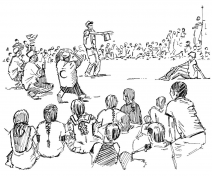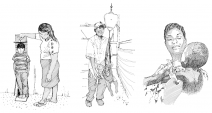15. Measuring acute malnutrition in emergencies
Overview
What is acute malnutrition?
When children do not have enough food or nutrients, it can affect their growth and development. A child with acute malnutrition is likely to be very thin, have a low weight for his or her height (wasting), and might have swelling, especially in the legs.
Why is measuring acute malnutrition important?
In emergencies or epidemics, more people tend to suffer from acute malnutrition because they lack nutritious food, are unable to provide appropriate feeding care, lack access to clean water and sanitation, and have limited access to health services. As a result of malnutrition, they may become ill and find it more difficult to fight disease. A child under five years old with acute malnutrition is more likely to become ill and to die than other children. The earlier a malnourished child is identified and referred to health care services, the more likely it is that she or he will recover and survive.
What to do and how to do it
Preparing to screen for malnutrition
- Find out the location of the nearest health services for treating malnutrition, the types of malnutrition they treat, and how you can refer children and their parents to them. Some programmes provide referral papers for families. The facility should be able to let you know what is required for a referral (for example, mid upper arm circumference, or MUAC, measure).
**You should only begin screening for malnutrition IF there are appropriate treatment centres, validated by a health professional, to which to refer people**
- Select appropriate screening location(s). Potential screening locations include:
- At home, in the market, in religious centres, during meetings or ceremonies (baptisms, marriages, funerals)
- At Oral Rehydration Point (ORP) sites, where non-food items (NFIs) or food rations are distributed, or during vaccination campaigns, etc.
- In health facilities (clinics, as part of routine growth monitoring) or during outreach visits (for immunization or health education)
- Arrange special mass screenings when malnutrition rates are very high
Screening for malnutrition
Mid upper arm circumference (MUAC) screening can be done on anyone over the age of six months and is commonly used for children six to 59 months (six months up to five years). The size of the MUAC tape is different for different age groups. Make sure you are using the correct size of MUAC for the age group you are measuring.
- Measure the mid upper arm circumference (MUAC). This identifies “wasted” (thin) people.
- Wrap a coloured or numbered MUAC tape round the left arm of the person you are screening (see Action Tool Measuring mid upper arm circumference for instructions).
- If the circumference of the arm falls within the red or yellow indicator, the person is likely malnourished and should be referred urgently for medical and nutritional care.
Community support for the management of malnutrition
- The earlier a malnourished child is identified and referred to healthcare services, the more likely it is that she or he will recover and survive.
- Refer any person with a red or yellow MUAC to the closest health or nutrition centre
- Support in-patient care.
- If a child is very sick and requires referral to an in-patient facility or hospital, assist the family to take the child
- If the family refuses, visit at home and continue to encourage referral
- Supportive home visits and follow-up can help children both to recover and to continue with their treatment.
- Check that referred children go for care and follow up. If parents and carers are not supported, they may discontinue treatment and the child can very quickly return to being malnourished
- Check to ensure that medicines and nutrition supplements (paste or cereal) are given correctly.
- Encourage caregivers to continue treatment as indicated by the health professional
- Nutrition supplements should not be shared with other family members or with the community but should be considered a medicine; sharing will slow the child’s recovery
- Visit the homes of children who have missed treatment to find out why.
- Encourage them to return and continue care if they can
- Give the health team the information you obtain and, if possible, try to link the health facility staff and the parents via phone, if they cannot or will not attend the centre
- Support families when parents cannot or refuse to visit the hospital to which their children have been referred

